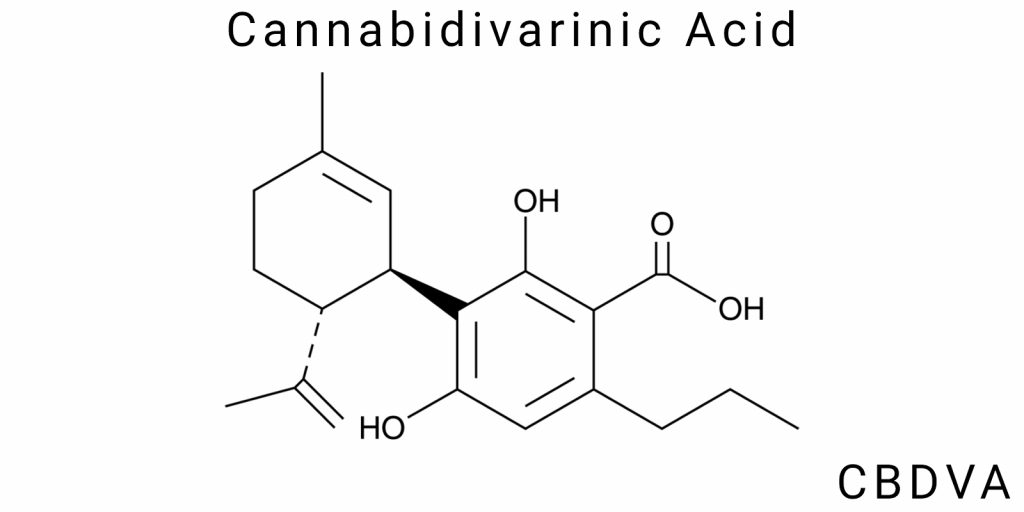Cannabidivarinic acid (CBDVA) is an important molecule in the context of emerging cannabinoid research, gaining increasing attention due to its potential therapeutic properties. Distinct from other cannabinoids such as CBD and THC, CBDVA belongs to the varin group of cannabinoids, characterized by the presence of a propyl side chain in its chemical structure, which significantly influences its physiological activity. As a derivative of cannabidivarin, its properties are very similar, yet there are some important differences that may make it even more promising in medical practice.
At the molecular level, CBDVA influences a wide range of biological mechanisms due to its ability to interact with various receptors and ion channels. It possesses a unique capability to interact with TRP channels (transient receptor potential channels), particularly with TRPV1, TRPV2, and TRPA1, which are crucial for pain perception, temperature sensation, and inflammatory processes. Therefore, the primary interest in CBDVA focuses on its ability to modulate pain and inflammation that arise from chronic diseases or injuries.
One of the distinctive features of CBDVA is its ability to actively inhibit the excessive activation of certain TRP channels that are responsible for pain and inflammation. Specifically, its influence on TRPV1 enables the reduction of painful sensations that often occur in conditions such as arthritis, injuries, or neuropathic disorders, making it a promising candidate for the treatment of chronic pain. Furthermore, CBDVA’s interaction with TRPV2 channels opens new opportunities for investigating its application in the treatment of diseases associated with cellular proliferation, such as cancer.
Given its ability to alleviate symptoms of pain and inflammation, CBDVA holds significant potential for the therapy of neurological disorders, particularly epilepsy and neuropathies. Early research indicates its effectiveness in reducing the frequency of seizures, thereby opening new horizons for the treatment of rare and severe forms of epilepsy that are resistant to standard therapies. The therapeutic potential of CBDVA also extends to a range of other conditions, such as disorders related to impaired temperature sensitivity, and it may become an important component of comprehensive treatment approaches for pain and inflammation.
In addition, CBDVA demonstrates intriguing activity in the context of oncology. Its effects on cellular processes associated with proliferation, apoptosis, and ion transport may be beneficial in inhibiting tumor development or progression. This lays the groundwork for the development of new therapeutic strategies in the fight against cancer, especially when combined with other treatment methods.
Biochemistry of the Therapeutic Effects of Cannabidivarinic Acid (CBDVA)
Cannabidivarinic acid (CBDVA) is a promising molecule with biochemical mechanisms that offer new therapeutic opportunities for treating diseases where traditional approaches have limitations. It holds potential for alleviating pain, reducing inflammation, and providing neuroprotection through interactions with CB1 and CB2 receptors of the endocannabinoid system and TRP channels involved in pain transmission. CBDVA may reduce neuropathic pain, diminish inflammation in autoimmune diseases, and promote neuroprotection in cases of neurodegenerative conditions such as Alzheimer’s disease and Parkinson’s disease.
Of particular importance is CBDVA’s ability to activate various TRP channels, including TRPV1, TRPA1, and TRPM8, which are responsible for the perception of pain, temperature, and chemical stimuli. This enables the reduction of pain associated with inflammation, toxic damage, or disorders of temperature sensitivity. CBDVA is also capable of modulating antioxidant mechanisms, making it beneficial for protecting neurons against oxidative stress, thereby reducing the risk of neurodegeneration and cellular damage. Thus, it opens new horizons for the treatment of chronic pain, inflammation, and neurodegenerative diseases.
Impact on Receptors and Channels Regulating Pain and Inflammation
Cannabidivarinic acid (CBDVA), through its ability to interact with specific ion channels and receptors, plays an important role in reducing pain and regulating inflammation. One of its primary targets is transient receptor potential channels (TRP channels), specifically TRPV1, TRPA1, and TRPM8. Studying CBDVA’s impact on these channels provides insights into the mechanisms by which this molecule alleviates pain, reduces inflammation, and even influences the body’s thermoregulation.
TRPV1, known for its activity in response to heat and acids, is a critical target for analgesia. Activation of this channel typically leads to pain; however, CBDVA, by inhibiting its activity, can reduce the excessive excitation of pain receptors, thereby lowering sensitivity to pain, especially under conditions of chronic pain, inflammation, or neurological disorders. Additionally, cannabidivarinic acid can inhibit the hyperactivity of TRPA1, a channel involved in pain caused by inflammatory and oxidative processes in the body. Inhibition of this channel may assist in the therapy of diseases where pain has not only a mechanical but also a chemical etiology, such as arthritis, migraines, or neuropathic pain.
CBDVA also has the ability to activate or inhibit TRPM8, which is usually responsible for the sensation of cold. Activation of this channel typically causes a cooling sensation, which can be beneficial in treating pain or inflammatory processes associated with elevated temperature. Since TRPM8 plays an active role in thermoregulation, CBDVA may utilize this channel to restore the body’s temperature balance, thereby reducing inflammatory processes accompanied by elevated temperature or swelling.
Anti-Inflammatory Effect and Impact on the Immune System
Inflammation is one of the main pathogenic mechanisms for numerous diseases, such as arthritis, ulcerative colitis, chronic respiratory diseases, and other autoimmune disorders. Cannabidivarinic acid (CBDVA) plays a significant role in regulating inflammatory processes through its ability to modulate the activation of cytokines, chemokines, and other molecules involved in the immune response. CBDVA’s interaction with these molecules enables the reduction of inflammation intensity and the normalization of immune system function.
One of the key mechanisms through which CBDVA affects inflammation is its ability to inhibit the release of molecules that initiate and sustain inflammation, such as TNF. These molecules are actively involved in infectious and autoimmune processes where they contribute to the development of inflammatory changes in tissues. Studying the mechanisms by which CBDVA modulates the activity of these molecules allows for the identification of CBDVA as a potent agent for treating inflammatory diseases such as osteoarthritis, acute respiratory distress syndrome (ARDS), and disorders of autoimmune nature.
CBDVA also interacts with molecules that regulate antioxidant activity mechanisms in the body. For example, it can promote increased activity of glutathione and other antioxidants that help reduce oxidative stress levels. This not only decreases inflammation but also prevents cell damage resulting from chronic inflammation and oxidation. CBDVA’s influence on antioxidant mechanisms opens additional opportunities for treating diseases accompanied by persistent inflammation and tissue damage.
Furthermore, reducing the levels of nitric oxide (NO) also has a significant anti-inflammatory effect. Nitric oxide is a molecule that, although performing important functions in regulating blood circulation and immune response, can cause inflammatory changes in tissues when present in excessive amounts. CBDVA is capable of regulating NO levels in the body, positively influencing inflammatory processes, particularly in the cardiovascular system and the gastrointestinal tract.
Synthesis and Stability of CBDVA in Nature
Biosynthesis of Cannabidivarinic Acid in Cannabis Plants
Cannabidivarinic acid (CBDVA) is formed in cannabis plants through a complex biosynthetic process based on the transformation of natural precursors. This pathway, which leads to the synthesis of CBDVA, is part of the broader cannabinoid biosynthetic system, which includes numerous enzymatic steps responsible for chemical modifications of molecules within the plant. The main goal of this process is the formation of specific cannabinoids, such as cannabidivarin (CBDV), which play important roles in biological responses of the organism.
The initial stage of CBDVA biosynthesis involves the synthesis of cannabichromenic acid (CBCA) through the action of the enzyme cannabichromenic acid synthase. Cannabichromenic acid serves as a precursor for the formation of various cannabinoids, including CBDVA, through a series of enzymatic reactions. However, the pathway converting CBCA into CBDVA is specific to certain cannabis strains, determined by the plant’s genetic properties. This transformation involves methylation, resulting in the conversion of cannabichromenic acid into cannabidivarinic acid.
A key role in the synthesis of CBDVA is played by specialized trichome cells located on the surface of the cannabis plant. These cells have a high content of cannabinoids and specialize in their synthesis. They provide the accumulation of cannabinoids, including CBDVA, and conduct a significant portion of the biosynthetic processes responsible for the formation of different cannabinoid molecules. It is important to note that the level of cannabidivarinic acid in plants can vary significantly depending on several factors: genetic characteristics, cultivation conditions, as well as climatic and agronomic factors.
Stability of CBDVA and Its Longevity in Nature
The stability of cannabidivarinic acid (CBDVA) is a key aspect of its functionality and its potential for use in medical applications. Chemical and physical processes occurring in the environment can impact its stability. One of the primary factors influencing CBDVA stability is its susceptibility to degradation under external conditions such as temperature, lighting, humidity, and oxygen levels. These factors determine the duration of its effectiveness as a therapeutic agent and the conditions required for its storage.
CBDVA demonstrates a high level of stability in dark environments and at low temperatures, which are optimal for preserving its molecular integrity. Light, particularly ultraviolet light, can induce photochemical reactions that accelerate the breakdown of the molecule, converting it into other cannabinoids or byproduct compounds. Such changes can reduce the effectiveness of CBDVA and alter its therapeutic properties. In turn, the stability of CBDVA in nature also depends on its ability to be preserved in an acidic environment, as cannabinoids in this form are less prone to degradation.
A notable aspect of CBDVA stability is its tendency to undergo decarboxylation—a process in which the acidic form of CBDVA is converted into cannabidivarin (CBDV) under the influence of heat or chemical factors. This transformation activates the molecule, making it more bioactive and able to interact with CB1 and CB2 receptors, which is a critical aspect when using CBDVA for medical purposes. This decarboxylation also has practical importance for various methods of cannabis extraction and thermal processing.
Environmental factors also play a significant role in the stability of CBDVA in nature. Soil moisture, temperature fluctuations, and light exposure can influence the ability of cannabis plants to synthesize and accumulate cannabidivarinic acid. Plants exposed to stress factors, such as changes in temperature or reduced water availability, may increase the production of CBDVA as an adaptive mechanism to unfavorable conditions. However, at high temperatures or under intense sunlight exposure, the level of CBDVA in the plant may decrease due to photodegradation and other chemical reactions.
Extraction Technologies for Cannabidivarinic Acid (CBDVA)
Extraction of cannabidivarinic acid is a complex process that requires consideration of the specific physicochemical characteristics of this molecule in order to preserve its stability and biological activity. CBDVA is the acidic form of cannabidivarin (CBDV), and during extraction and processing, it is crucial to minimize its conversion into more stable but less active forms. Therefore, the application of the correct extraction technology is of utmost importance for preserving the properties of CBDVA and obtaining high-quality products.
One of the main tasks during extraction is minimizing oxidation and photochemical reactions, as these processes can lead to the breakdown of the molecule and reduce its therapeutic effects. To achieve this, extraction methods are used that minimize the exposure of the mixture to light and oxygen. Among the most popular methods are solvent extraction using liquids such as ethanol, as well as CO₂ extraction methods, which allow for the preservation of the maximum amount of cannabinoids in their original form.
Key Extraction Methods to Preserve CBDVA Stability
- CO₂ Extraction (Supercritical Extraction)
Supercritical CO₂ extraction is one of the most effective methods for preserving cannabidivarinic acid. This method allows the use of CO₂ in a state between liquid and gaseous, ensuring high process efficiency. Supercritical extraction enables precise selection of temperature and pressure ranges, preserving the stability of sensitive molecules like CBDVA. This method has the advantage of minimizing the impact of high temperatures and oxidation, maintaining the full spectrum of cannabinoids and terpenes in the final extract. As a result, it ensures not only high efficiency but also the safety of the obtained product. - Ethanol Extraction
The ethanol extraction method is one of the most common, as it effectively extracts a wide range of cannabinoids, including CBDVA. However, it is essential to use ethanol at low temperatures to prevent decarboxylation of cannabidivarinic acid (CBDVA) into cannabidivarin (CBDV), which could reduce the efficiency of the extraction. To preserve the stability of CBDVA during ethanol extraction, cold extraction or extraction at low temperatures is used, which minimizes the risk of molecular degradation due to thermal processes. In addition, the use of filtration techniques and further processing of the extract allows for the retention of a greater proportion of active compounds, including CBDVA. - Microwave and Ultrasonic Extraction
Innovative methods such as microwave and ultrasonic extraction allow for a reduction in processing temperature, thereby minimizing the risks of molecule breakdown at high temperatures. These methods activate molecules using mechanical or wave oscillations, ensuring a rapid and efficient extraction process. They allow for more precise control over parameters, ensuring the preservation of CBDVA stability. - Extraction Using Liquid Solvents (Butane, Pentane)
This method uses organic solvents that can effectively extract cannabinoids from plant material. However, to preserve the stability of CBDVA, it is necessary to control the temperature of the process and ensure proper filtration to minimize oxidation. This approach allows for the extraction of CBDVA and other cannabinoids, but requires careful handling.
Storage of Cannabidivarinic Acid After Extraction
The storage of cannabidivarinic acid (CBDVA) after extraction is crucial for ensuring its stability and preserving its biological activity. One of the primary factors influencing this process is temperature. To prevent degradation of CBDVA, it is recommended to store extracts at low temperatures, as elevated temperatures can accelerate chemical reactions, such as decarboxylation, which converts the acid into cannabidivarin (CBDV), a less stable and active cannabinoid. Storing extracts at temperatures between 4°C and 10°C helps minimize these reactions and preserves the stability of the molecules. Additionally, it is important to protect the extracts from light, which can induce photochemical reactions that lead to oxidation of CBDVA. For this reason, extracts should be stored in opaque containers to avoid exposure to ultraviolet radiation.
Humidity control is also an important factor when storing CBDVA extracts, as elevated humidity can accelerate hydrolysis of the molecules and promote chemical processes that lead to a reduction in product quality. Extracts should be stored in a dry environment to prevent such processes. Furthermore, during long-term storage, unpredictable changes may occur, such as the conversion of CBDVA into other cannabinoids or byproducts, necessitating the use of additional stabilization methods. One such method is the addition of antioxidants, which can significantly slow down oxidative processes, thereby extending the shelf life of the extract without losing activity. Antioxidants such as vitamin E are used to reduce the impact of oxygen on CBDVA molecules.
The storage of cannabidivarinic acid also requires precise control of conditions, as even under ideal conditions, some molecules may still undergo change. Therefore, to preserve the maximum therapeutic potential of cannabidivarinic acid, it is essential not only to properly store the extracts but also to carefully control all stages of production, including extraction and further processing. This ensures the high quality of cannabidivarin-based products, which can be used to treat a variety of conditions such as chronic pain, inflammation, and other states where CBDVA may have a positive effect.
CBDVA Extract Stabilization Technologies
To ensure the long-term stability of CBDVA, it is essential to consider the ecological and physiological factors that influence its activity and effectiveness for medical purposes. Technologies that help avoid the impact of unfavorable factors on the storage of CBDVA are critical for the development of products that can maintain their effectiveness over an extended period, which is an important aspect for pharmaceutical companies working with cannabinoids. To prevent the degradation of CBDVA molecules, innovative stabilization methods are used, including the introduction of inert gases, such as nitrogen, into the product packaging. This helps reduce the contact of the extract with oxygen, which decreases oxidative processes.
Another important technology is the use of specialized packaging materials that provide a barrier to moisture and oxygen, such as multi-layered bags made from durable materials. These packaging materials create optimal storage conditions, significantly reducing the loss of active components over time. An essential aspect is also the scientific research focusing on the stability of cannabinoids in the long term, including factors that may affect their effectiveness after extraction and storage.
Molecular Targets of CBDVA: Anti-Inflammatory and Neurotropic Effects
Cannabidivarinic acid (CBDVA) is a natural cannabinoid that exhibits a wide range of biological effects due to its ability to interact with various molecular targets in the body. One of the most important targets of CBDVA are the cannabinoid receptors CB1 and CB2, as well as the transient receptor potential (TRP) channels. Through these molecular targets, CBDVA can reduce inflammatory processes, promote neuroprotection, and regulate various functions such as pain, thermoregulation, and immune responses. Its potential to reduce inflammation and neurological activity sets CBDVA apart from other cannabinoids, such as CBD and THC, making it valuable for the treatment of various diseases.
CBDVA has significant interest in the context of treating inflammatory diseases and neuropathy, as its interaction with molecular targets can reduce the activity of inflammatory markers and alleviate pain, particularly in chronic conditions.
CBDVA’s Interaction with Transient Receptor Potential (TRP) Channels
Transient receptor potential (TRP) channels are important molecular structures that regulate the transmission of sensory signals such as pain, temperature, and other factors related to the external environment. CBDVA interacts with several subtypes of these channels, including TRPV1 and TRPA1, which are crucial for pain perception and temperature changes. This is of particular importance for understanding the potential of CBDVA as an analgesic agent.
Studies of this interaction have shown that CBDVA can reduce the activity of TRPV1, a channel responsible for the sensation of pain that arises in various inflammatory conditions, injuries, or tissue damage. Reducing TRPV1 activity can lead to decreased pain intensity, as well as a reduction in the release of neuropeptides that support inflammatory processes in the body.
CBDVA also interacts with TRPA1, a channel involved in pain and temperature perception, especially in the peripheral nerves. Activation of TRPA1 can alleviate painful sensations associated with various neurological conditions. This makes CBDVA potentially effective in treating chronic pain, which is difficult to control with traditional analgesic drugs.
CBDVA’s Interaction with Cannabinoid Receptors
Another important target for CBDVA is the cannabinoid receptors CB1 and CB2, which are widely distributed throughout the body and play a critical role in modulating pain, mood, immune response, and other functions. CBDVA is capable of interacting with these receptors, although it is less effective than more well-known cannabinoids such as THC or CBD.
CB1 receptors are predominantly located in the central nervous system, and their activation is crucial for reducing pain and regulating neuroplasticity. CBDVA’s interaction with these receptors can decrease the activity of neurons that cause pain and promote neuroprotection, i.e., the protection of nerve cells from damage.
CB2 receptors, which are primarily found in immune cells, are essential for modulating the immune response and inflammatory processes. Activation of these receptors by CBDVA can reduce the activity of inflammatory molecules such as cytokines and chemokines, making this cannabinoid promising for treating diseases associated with inflammation, such as arthritis or autoimmune disorders.
Current state of preclinical research on cannabidiavarinic acid (CBDVA)
Current State of Preclinical Research
Study of the Mechanisms of Action of CBDVA in Preclinical Models: Prospects and Challenges
Preclinical studies on cannabidivarinic acid (CBDVA) encompass various mechanisms of its action at the molecular level, which provide deeper insight into its therapeutic potential. One of the key challenges is determining its impact on cannabinoid receptors CB1 and CB2, as well as on transient receptor potential (TRP) channels, which are involved in the regulation of pain and inflammatory processes in the body. Research suggests that CBDVA is capable of interacting with these molecular targets, but the mechanisms of its action remain insufficiently explored.
An important direction is studying its specificity of interaction with different subtypes of CB1 and CB2 receptors, as these receptors have different roles in the regulation of neuropathic pain, inflammation, and neurodegenerative processes. However, the effect of CBDVA on these receptors may vary depending on the tissue type or pathological state, which complicates the development of standardized therapeutic strategies. Investigating its interaction with TRP channels, particularly TRPV1 (which plays a significant role in pain sensitivity) and TRPA1, may open new perspectives for pain treatment, as these channels are also associated with inflammatory processes.
Preclinical animal models, especially those that mimic chronic pain and neuroinflammation, are actively used to assess the effect of CBDVA on these receptors. For example, studies involving models of diabetic neuropathy and chronic pain have found that CBDVA can reduce inflammation and pain manifestations. However, many aspects, such as dosage and timing of administration, still need to be clarified. One of the challenges is determining optimal therapy parameters to ensure that CBDVA does not cause side effects such as toxicity or interactions with other medications. This creates a need for further preclinical trials to explore all possible applications and identify effective mechanisms.
Prospects of CBDVA in Treating Chronic Diseases: Trends and Recent Developments
Preclinical studies indicate significant potential for cannabidivarinic acid (CBDVA) in the therapy of chronic diseases, particularly inflammatory and neuropathic conditions. The anti-inflammatory and analgesic properties of CBDVA make it promising for the treatment of diseases such as arthritis, chronic pain, multiple sclerosis, and other autoimmune and neurodegenerative disorders. Since CBDVA has properties similar to cannabidiol (CBD), but with some differences that make it capable of influencing other molecular targets, it opens new possibilities for therapeutic applications.
Studies of CBDVA in the context of chronic inflammatory diseases have shown that it can modulate the activity of immune cells, such as macrophages and microglia, which are important for reducing inflammatory processes. Additionally, research in animal models of chronic pain confirms CBDVA’s ability to reduce pain sensitivity without causing significant side effects. Special interest is given to its neuroprotective effect, which opens potential for CBDVA’s use in treating neurodegenerative diseases, such as Alzheimer’s or Parkinson’s disease, where oxidation processes and neuroinflammation are key pathogenic mechanisms.
Recent developments in this field also include the use of genetically modified animals to more precisely determine the mechanisms of CBDVA’s action at the molecular level. Thanks to these models, researchers can study how CBDVA interacts with specific genes that regulate inflammation and pain. These models not only allow a better understanding of CBDVA’s effectiveness in treating chronic diseases but also help assess its potential as a preventive therapy capable of stopping or slowing the progression of diseases such as neuropathy or autoimmune disorders.
Alongside clinical trials, research requires further standardization of dosing protocols and the determination of therapeutic doses to avoid toxicity and ensure the safe application of CBDVA in real-world conditions. This will form the basis for the development of new therapeutic agents based on cannabidivarinic acid.
Research Directions for CBDVA in the Context of Chronic Diseases
Preclinical studies on cannabidivarinic acid (CBDVA) are actively focused on its potential in the treatment of chronic diseases caused by inflammation and neuropathies, such as arthritis, multiple sclerosis, Alzheimer’s disease, Parkinson’s disease, and other neurodegenerative disorders. These pathologies are often accompanied by prolonged and severe symptoms of pain, inflammation, and decreased organ or tissue functionality, significantly worsening the quality of life for patients. Traditional treatment methods do not always yield the desired results, opening up prospects for the use of new therapeutic approaches, such as cannabidivarinic acid.
One of the important aspects of CBDVA research is its ability to modulate cellular activity. Inflammation and pain, as chronic conditions, can arise from prolonged disruption of homeostasis in the body, particularly as a result of excessive activation of immune cells or continuous tissue damage. CBDVA can influence these processes, helping to reduce symptom severity and improve the functional state of the body. Pain problems, especially in chronic diseases, often have a central nervous origin, where excessive activation of neurons and glial cells contributes to increased inflammation and dysfunction of the nervous system. Studying the mechanisms by which CBDVA can affect these cells is an important step toward its potential use as a therapeutic agent.
One area of research is studying CBDVA’s ability to interact with various molecular targets, particularly cannabinoid receptors (CB1 and CB2), TRP channels, and receptors that regulate pain and inflammation. CB1 and CB2 receptors, being crucial for modulating neuropathic pain, are significant for the therapy of neuropathies caused by injuries or inflammatory processes. CBDVA’s interaction with these receptors may help normalize pathological processes and reduce inflammation, providing effective pain relief. However, research also indicates the need for more precise identification of the mechanisms of this interaction and its impact on specific types of neurons and tissues.
Ethical Aspects of CBDVA Research and Production: Mental Health and Long-Term Effects
One of the key ethical aspects of cannabidivarinic acid (CBDVA) research is the need to carefully examine its impact on mental health. While CBDVA shows great promise for treating physical ailments, its effects on mental state and cognitive functions remain insufficiently studied. Since cannabidivarinic acid, like other cannabinoids, can interact with the central nervous system, its impact on neurotransmitter systems requires more detailed analysis. This issue is particularly important in the context of treating patients with mental health conditions or when treating elderly individuals, for whom even moderate changes in cognitive functions can lead to serious problems.
Moreover, gaps in clinical studies of CBDVA may result in potentially harmful effects going unnoticed at early stages. Therefore, ethical requirements for research include not only the precise determination of therapeutic doses but also an assessment of the potential long-term consequences of using cannabidivarinic acid. The absence of such data could jeopardize patient safety, requiring researchers to pay special attention to long-term trials, particularly with extended use of CBDVA.
Distribution of Access to CBDVA and Its Social Consequences
One of the main ethical concerns regarding the use of cannabidivarinic acid (CBDVA) is the issue of accessibility to this therapeutic agent. Like many other promising therapeutic agents, CBDVA may only be available to a limited group of people, raising concerns about social inequalities in healthcare. While the therapeutic effects of CBDVA may be significant for patients with chronic inflammatory and neuropathic diseases, its high cost or regulatory barriers may result in only certain socio-economic groups being able to afford these medicines.
Another issue is the potential restriction of access to such drugs in low-income countries or regions with limited resources for medical research. In these areas, the therapeutic benefits provided by cannabidivarinic acid may become inaccessible due to high product prices and a limited number of manufacturers capable of implementing the necessary production technologies.
Additionally, economic factors may lead to disparities in healthcare, where wealthier populations will receive better medical care based on CBDVA, while less affluent groups will be excluded from access to such treatment options. In this context, it is crucial to consider not only the ethical but also the social and economic aspects of accessibility and ensuring equal access to such medical innovations.
Conclusion
Cannabidivarinic acid (CBDVA) is a promising candidate for medical applications due to its unique pharmacological properties, particularly in the areas of chronic inflammation, pain, and neuropathies. To date, its ability to influence molecular targets, such as the cannabinoid receptors CB1 and CB2, as well as transient receptor potential (TRP) channels, creates new opportunities for developing therapeutic strategies that could significantly improve the quality of life for patients suffering from diseases like arthritis, multiple sclerosis, or chronic neuropathies.
Special attention should be paid to the potential of CBDVA in reducing neuroinflammation and protecting neurons from damage, which may help in the treatment of neurodegenerative diseases such as Alzheimer’s or Parkinson’s disease. However, despite promising preclinical results, it is important to note that many aspects of the mechanisms of action of CBDVA still require further research. For example, it is necessary to clearly define its interaction with different receptor subtypes and its role in cellular metabolism, which will allow for a more accurate prediction of potential effects at different doses.
From a production standpoint, one of the main challenges is the stability of CBDVA, as it may degrade when exposed to light, oxygen, or high temperatures. As a result, it is essential to optimize extraction and storage technologies to ensure the preservation of the biological activity of the molecule. The addition of antioxidants or the use of specialized containers may become a key factor in ensuring its long-term efficacy. This issue is particularly important in the context of its potential use in clinical settings, where the stability and quality of the product are critical to therapeutic outcomes.
In relation to the ethical challenges arising during the production and application of cannabidivarinic acid, it is important to note that the issue of access to new therapeutic agents must be considered in the context of social and economic factors. Ensuring proper regulation when using CBDVA in medicine is also crucial to avoid potential misuse or unauthorized use, especially in countries where cannabis and its derivatives may have varying legal status.
Despite the numerous prospects opened by CBDVA, for this cannabinoid to find its place in clinical practice, more clinical studies are needed to determine its safety and effectiveness in various contexts. This also includes examining potential side effects and interactions with other medications to ensure maximum benefit for patients.
References:
- PubMed (NCBI) – a large database containing scientific articles from medical and biological sciences. It is one of the best resources for finding articles on cannabinoid pharmacology, including CBDVA. https://pubmed.ncbi.nlm.nih.gov
- Google Scholar – a search engine for scientific articles, where research on cannabidivarinic acid, its stability, mechanisms of action, and therapeutic potential can be found. https://scholar.google.com
- ScienceDirect – a resource providing access to numerous scientific publications and articles on cannabis, including studies related to CBDVA and other cannabinoids. https://www.sciencedirect.com
- Nature Reviews Drug Discovery – a journal containing reviews on the latest advancements in pharmacology, including cannabinoid research .https://www.nature.com/nrd
- The Journal of Neuroscience – a specialized publication in neurobiology that publishes research on neuroprotection and the study of cannabinoid effects. https://www.jneurosci.org






